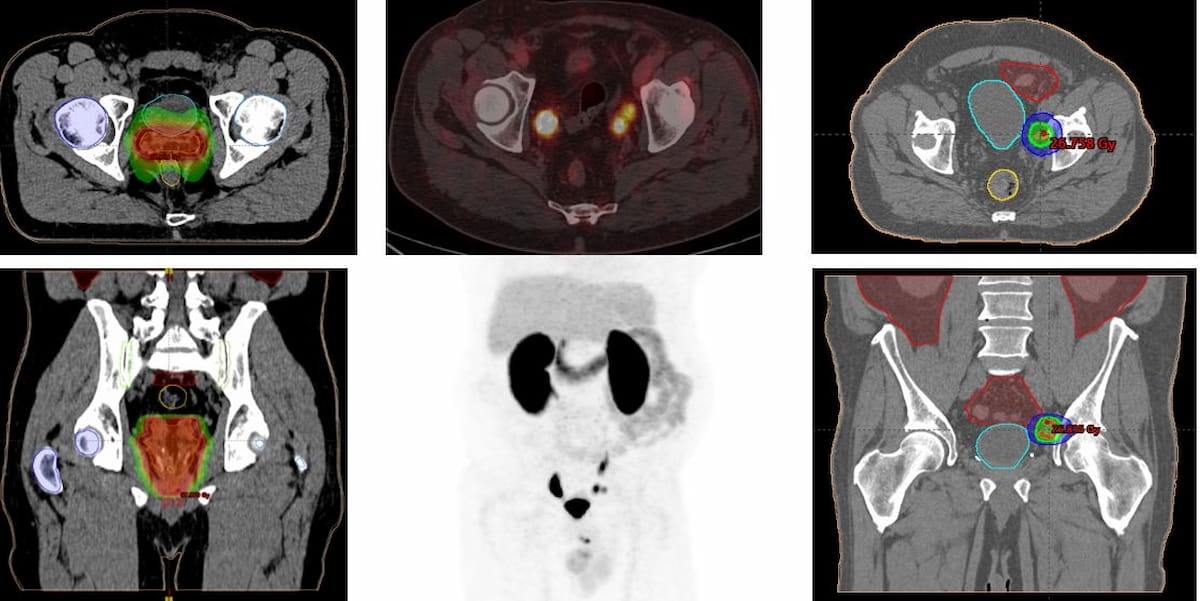SNMMI: PSMA-18F DCFPyL Changes Treatment for PCa Recurrence in Significant Number of Patients with Low PSAs
In a cohort of 85 patients with biomechanical recurrence of prostate cancer and PSA values less than 2 ng/mL, positive findings on PET imaging with PSMA-18F DCFPyL led to treatment changes in the majority of patients who had negative findings on conventional imaging, according to new research presented at the SNMMI conference.
The use of PSMA-18F DCFPyL may be more advantageous than conventional imaging in detecting biomechanical recurrence of prostate cancer in patients with low prostate-specific antigen (PSA) values, according to new research presented at the 2024 Society of Nuclear Medicine and Molecular Imaging (SNMMI) Annual Meeting.
For the retrospective study, researchers evaluated the use of PET PSMA-18F DCFPyL (Pylarify, Lantheus) in 85 patients (mean age of 69) who had occult prostate cancer recurrence and PSA values less than 2 ng/mL. All patients in the cohort had negative computed tomography (CT), magnetic resonance imaging (MRI), ultrasound and positron emission tomography (PET)-choline exams, according to the study authors.
At a six-month follow-up, the researchers found that PET imaging with PSMA-18F DCFPyL led to treatment changes in 75 percent of patients with positive findings (31/41).
Here one can see PET/CT imaging with PSMA-18F DCFPyL that led to modification with a planned radiotherapy treatment for recurrent prostate cancer. (Images courtesy of SNMMI.)

“In PET-PSMA-positive patients, the therapeutic changes found were classified as indicating or changing the planning of salvage radiotherapy treatment and/or initiating systemic treatment with hormone therapy,” noted lead study author Pedro Jose Plana Lopez, M.D., who is affiliated with Hospital Del Mar in Barcelona, Spain, and colleagues.
The study authors noted a median PSA level of 0.08 ng/dL after treatment changes were instituted in patients with positive PET PSMA results.
(Editor’s note: For related content, see “Can an Emerging PET Radiotracer Be a Viable Alternative to Multiparametric MRI for Detecting Prostate Cancer Recurrence?,” “Utilizing AI for Quantitative Assessment of Prostate Cancer Recurrence” and “Emerging PET Radiotracer May Offer Multiple Advantages in Detecting Prostate Cancer.”)
“PET-PSMA is a powerful diagnostic tool for patients with occult biochemical recurrence with PSA < 2ng/mL,” added Lopez and colleagues.
Reference
1. Lopez PJP, Amorelli FG, Cano JSB, et al. PET/CT PSMA-18F DCFPyL promotes treatment changes in occult biochemical recurrence of prostate carcinoma even with low PSA values. Presented at the 2024 Society of Nuclear Medicine and Molecular Imaging Annual Meeting, June 8-11, Toronto, Canada. Available at: https://www.xcdsystem.com/snmmi/program/10OD8Tq/index.cfm . Accessed June 9, 2024.
GE HealthCare Debuts AI-Powered Cardiac CT Device at ACC Conference
April 1st 2025Featuring enhanced low-dose image quality with motion-free images, the Revolution Vibe CT system reportedly facilitates improved diagnostic clarity for patients with conditions ranging from in-stent restenosis to atrial fibrillation.
The Reading Room Podcast: Current Perspectives on the Updated Appropriate Use Criteria for Brain PET
March 18th 2025In a new podcast, Satoshi Minoshima, M.D., Ph.D., and James Williams, Ph.D., share their insights on the recently updated appropriate use criteria for amyloid PET and tau PET in patients with mild cognitive impairment.
Expanded FDA Approval Allows Use of Pluvicto Prior to Chemotherapy in Patients with mCRPC
March 28th 2025Recent research demonstrated a 59 percent reduced risk of progression or death with the radioligand therapy Pluvicto in comparison to a change of androgen receptor pathway inhibitor (ARPI) for patients with metastatic castration-resistant prostate cancer (mCRPC).
New AI-Enabled Portable Ultrasound May Facilitate 50 Percent Reduction in Cardiac Imaging Scan Time
March 28th 2025Artificial intelligence (AI)-powered measurement capabilities provide key features with the Compact Ultrasound 5500CV device, which was unveiled at the American College of Cardiology (ACC) conference.
GE HealthCare Launches PET MPI Agent Flyrcado at ACC Conference
March 28th 2025The positron emission tomography myocardial perfusion imaging (PET MPI) agent, which offers a significantly higher half-life than other cardiac PET agents, was recently granted pass-through payment status by CMS that will go into effect on April 1, 2025.
New Collaboration Offers Promise of Automating Prior Authorizations in Radiology with AI
March 26th 2025In addition to a variety of tools to promote radiology workflow efficiencies, the integration of the Gravity AI tools into the PowerServer RIS platform may reduce time-consuming prior authorizations to minutes for completion.